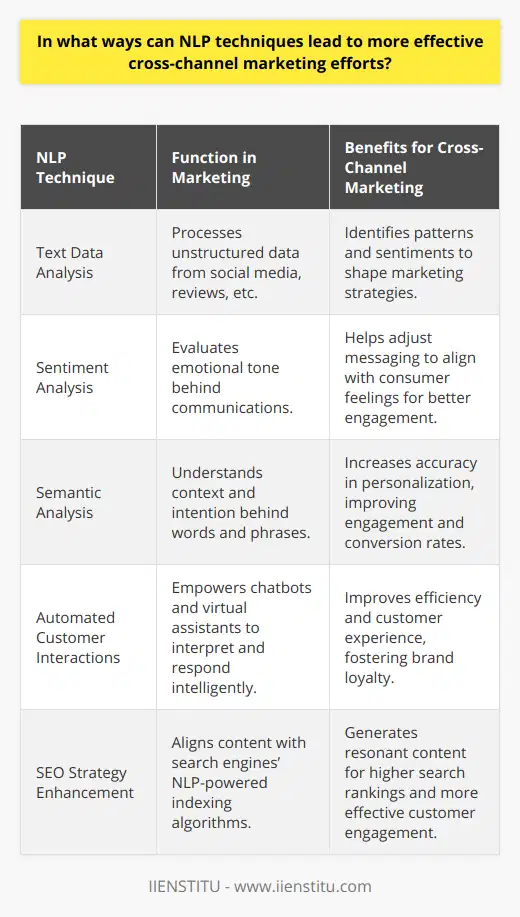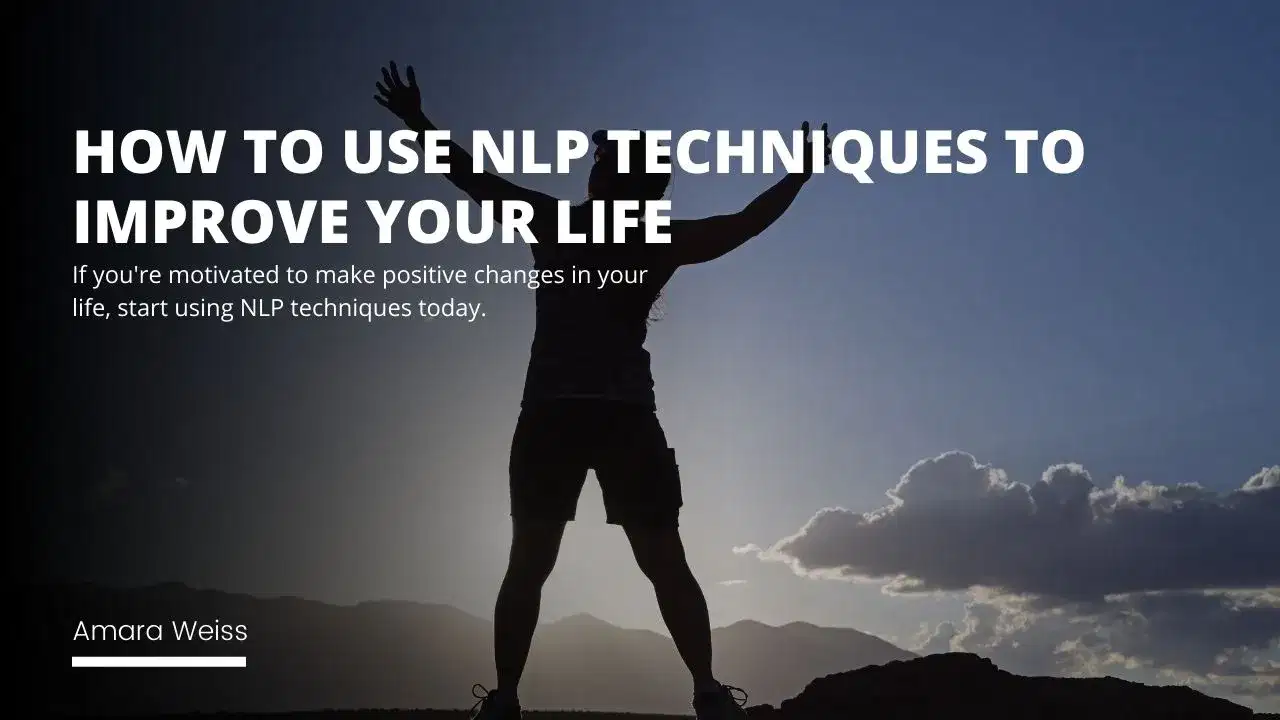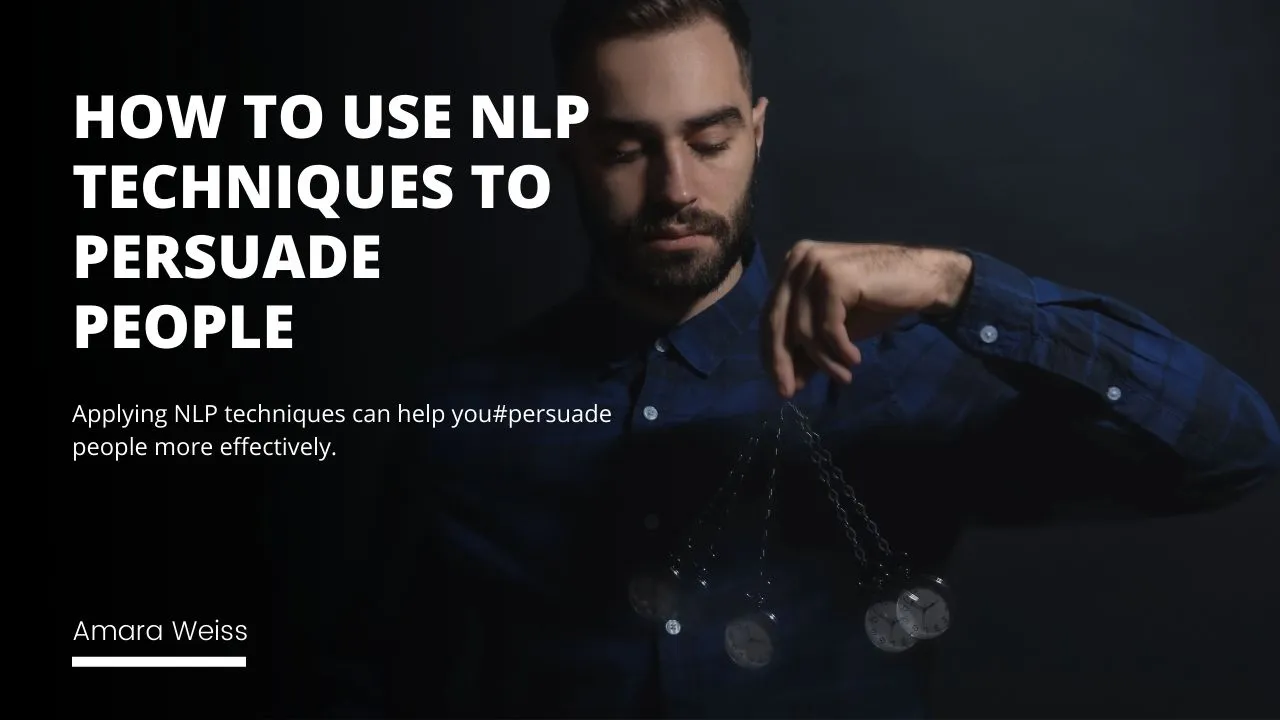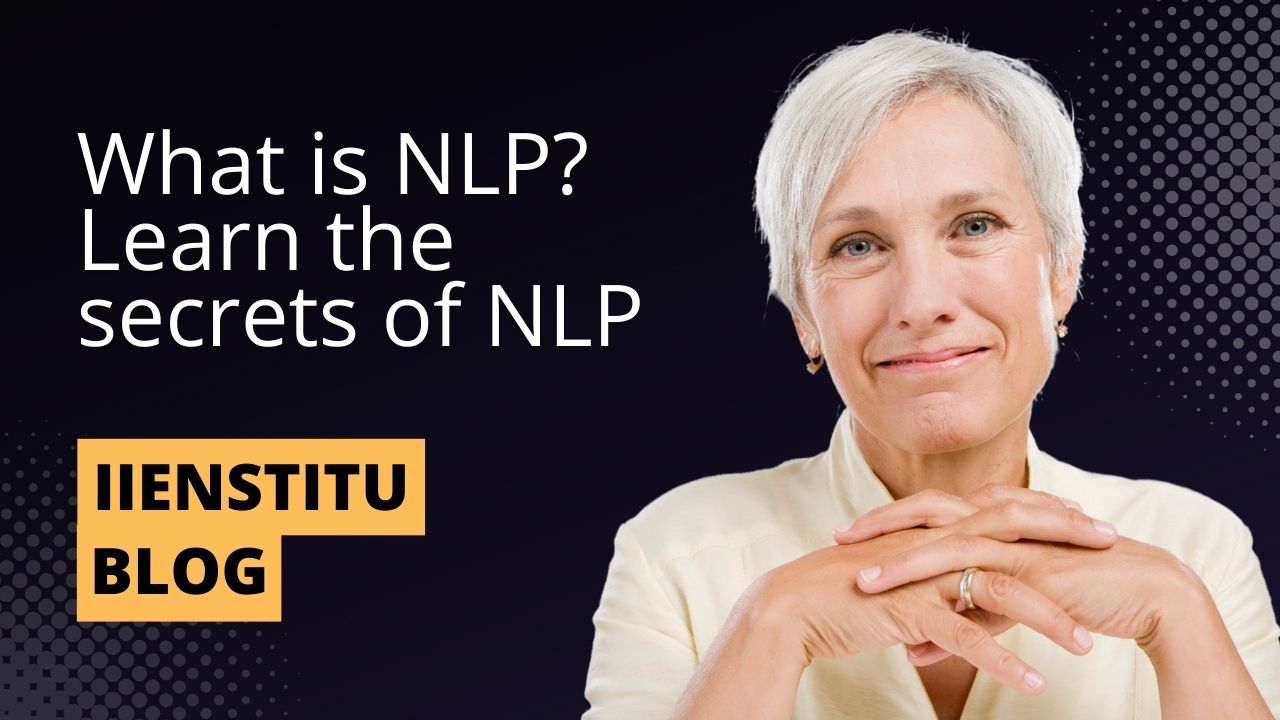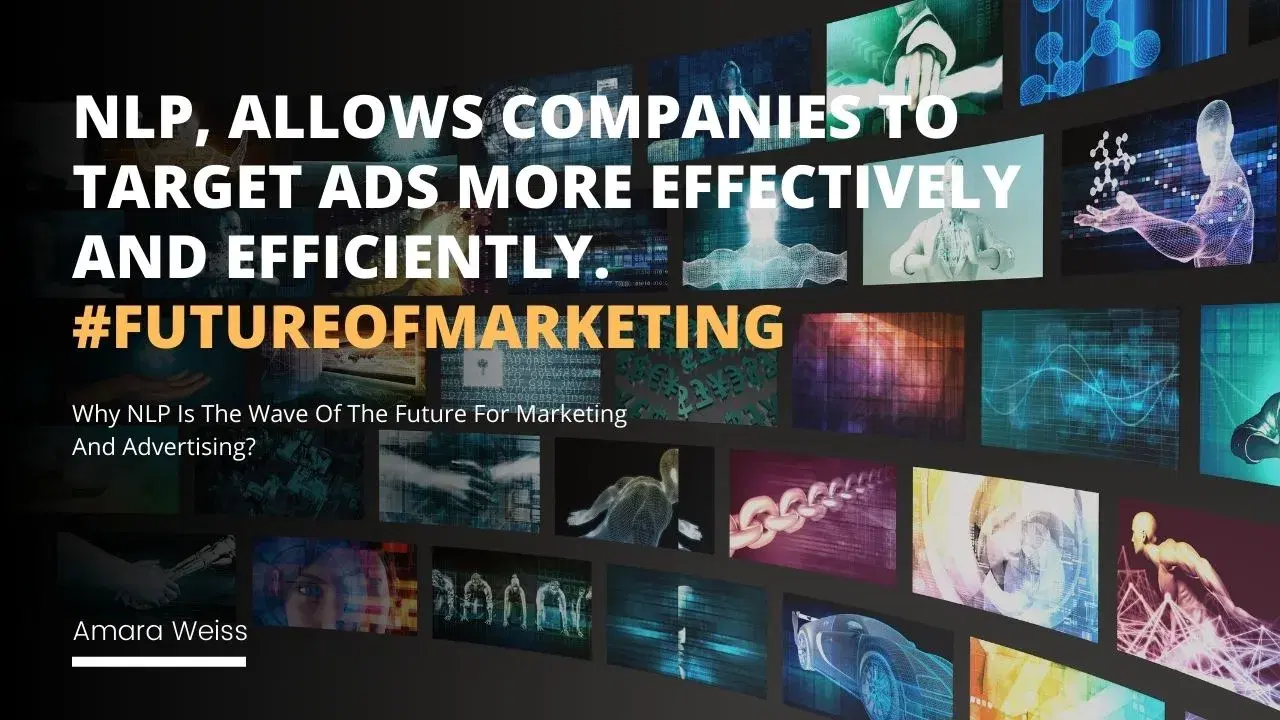
NLP, or Neuro-Linguistic Programming, is a technique that uses the power of language to influence and control thoughts and behaviors. It enables people to connect with others emotionally, making them more likely to be affected by what is said. Because of this, NLP has become an increasingly popular tool for marketers and advertisers who want to create powerful connections with their audience. Although it may seem like magic, NLP is based on scientific principles and can be learned by anyone. So if you're looking for a way to stand out from the competition, consider learning about NLP and how you can use it in your marketing and advertising campaigns.
What is NLP, and how can it be used in marketing and advertising?
NLP can be used in several different ways to improve the effectiveness of marketing and advertising campaigns. For example, NLP can be used to:
Persuade people to take action
Convince people to buy a product or service
Change people's perception of a brand
Improve communication between businesses and customers
Boost customer satisfaction level
There are many benefits of using NLP in marketing and advertising, including:
It's a potent tool that can help you achieve your objectives.
It's relatively easy to learn and can be used by anyone.
It helps you create strong emotional connections with your audience.
It can be used in several different ways to improve your campaigns.
If you're looking for a way to take your marketing and advertising to the next level, consider using NLP. With its ability to create powerful emotional connections, NLP is the future wave for marketing and advertising.
How to use NLP in your marketing and advertising campaigns
Using NLP in your marketing and advertising campaigns is relatively easy. First, you need to learn how to use it and apply it to your campaigns. Here are a few tips on how you can use NLP in your marketing and advertising:
Use language that engages the emotions: When you're crafting your marketing and advertising messages, be sure to use language that will resonate with your audience emotionally. This will make them more likely to be persuaded by what you're saying.
Tell stories: Stories are a great way to connect with your audience and get them to remember your message. When creating your marketing and advertising materials, be sure to tell stories that will stick with your audience long after they've seen or heard them.
Use visuals: Visuals are another great way to connect with your audience and make your message more memorable. When you're creating your marketing and advertising materials, be sure to use visuals that will capture your audience's attention and help them understand your message.
Examples of successful NLP-based marketing and advertising campaigns
In the early 2000s, a cereal company used NLP to create a series of ads that featured a character named "Mikey." The ads were designed to target children, and they featured Mikey doing things like riding a bike and playing with his friends. The ads successfully got kids to eat more cereal, and they also helped increase the company's sales.
Another example of a successful NLP-based marketing campaign comes from a car company. The company created an ad that featured a woman driving a car on a windy day. The ad was designed to show how the car's winds deflected the wind, making it safer for the driver. The ad successfully got people to buy the car, and it helped increase the company's sales.
NLP has also been used successfully in political campaigns. For example, in 2012, Barack Obama's campaign used NLP to create ads that targeted undecided voters. The ads successfully got people to vote for Obama, and they helped him win the election.
These are just a few examples of successful NLP-based marketing and advertising campaigns. NLP was used to create a compelling message that resonated with people and led in each case.
NLP has been used successfully in several different marketing and advertising campaigns. Here are a few examples of successful NLP-based campaigns:
In 2003, McDonald's launched its "I'm lovin' it" campaign, designed to create an emotional connection with consumers. The campaign used various techniques, including music, celebrities, and positive language. One of the most compelling aspects of the campaign was its use of Neuro-Linguistic Programming (NLP). NLP is a psychological manipulation that involves using language to influence someone's thoughts and emotions. For instance, the phrase "I'm lovin' it" triggers positive feelings associated with love and happiness. By repeatedly exposing people to this phrase, McDonald's created a subconscious association between its products and these positive emotions. As a result, many people began to crave McDonald's food when they saw the "I'm lovin' it" slogan. This campaign demonstrates the power of NLP to create an emotional connection with consumers and convince them to buy products they might not otherwise purchase.
In 2010, Old Spice launched a highly successful marketing campaign that changed people's perception of the brand and helped make it more attractive to men. The campaign, which featured the slogan "The man your man could smell like," was based on the idea of using NLP to change people's beliefs about the brand. The ads showed an attractive, well-dressed man who smelled great and had a lot of success with women. They also included a call to action, telling viewers to "Smell like a man." The campaign was highly effective, and it helped significantly increase sales of Old Spice products.
Dove has been at the forefront of celebrating natural beauty in recent years. The brand's "Real Beauty" campaign proved to be a highly effective use of NLP, helping to improve communication between Dove and its customers. The result was a significant boost in customer satisfaction levels. By using NLP techniques, Dove quickly understood the needs and concerns of its customers. This allowed the company to create targeted messages that resonated with its audience. In addition, the use of NLP helped Dove to build deeper relationships with its customers. These strong bonds helped create a loyal customer base that was highly satisfied with the brand.
The future of NLP in marketing and advertising
NLP, or Neuro-Linguistic Programming, is a potent tool that will only become more popular in marketing and advertising. NLP allows businesses to create emotional connections with their audiences by understanding and utilizing the power of language. So if you're looking for a way to take your marketing and advertising to the next level, be sure to keep an eye on NLP. It's the wave of the future for marketing and advertising. By using NLP, businesses will be able to create more powerful and effective campaigns that resonate with their audiences on a deep level. So if you're looking to stay ahead of the curve in marketing and advertising, be sure to keep an eye on NLP. It's the future of marketing and advertising.
In conclusion, NLP is a powerful tool that can be used to improve marketing and advertising campaigns. By understanding how it works, you can use it to influence customer behavior and drive sales. There are many benefits to using NLP in marketing and advertising, such as increased engagement, improved response rates, and better customer retention. You can also use NLP to create more persuasive content and build stronger relationships with your customers. While there are many successful examples of NLP-based marketing and advertising, the future of this approach looks even brighter. With the help of NLP, businesses will be able to understand better and influence customer behavior, leading to more sales and more loyal customers.
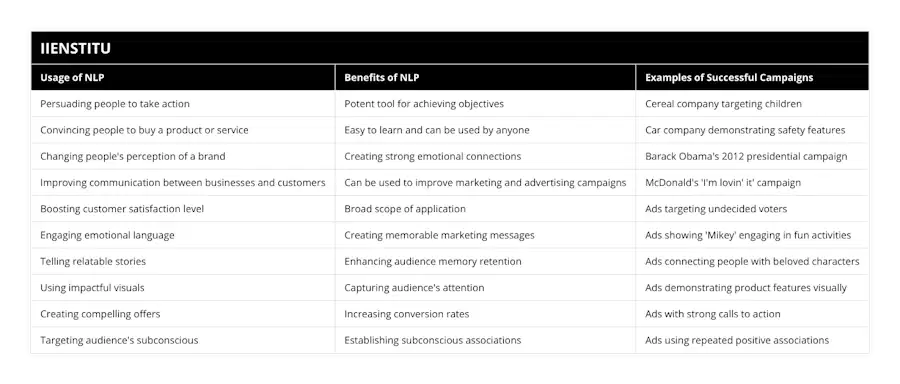
Frequently Asked Questions
How can NLP be used in marketing?
There are many ways that NLP (natural language processing) can be used in marketing. For example, NLP can be used to analyze customer sentiment in social media posts or reviews, to understand what customers are saying about a product or service. This information can then be used to improve marketing strategies or develop new advertising campaigns. Additionally, NLP can be used to target consumers with ads based on their search history or online behavior. Finally, NLP can also be used to create chatbots or virtual assistants that interact with customers on behalf of a company. All of these applications of NLP show how this technology can be used to benefit marketing efforts and improve customer experiences.
What are some of the benefits of using NLP in marketing?
NLP can help you to understand how people process information, which can then help you to tailor your marketing messages in a way that is more likely to be understood and remembered.
NLP can also help you to build better relationships with your customers by improving your ability to communicate effectively with them. This can lead to increased customer loyalty and advocacy.
Lastly, NLP can help you to manage your own emotions and reactions in order to stay calm and professional under pressure. This can be especially beneficial in high-stress situations such as negotiations or interactions with difficult customers.
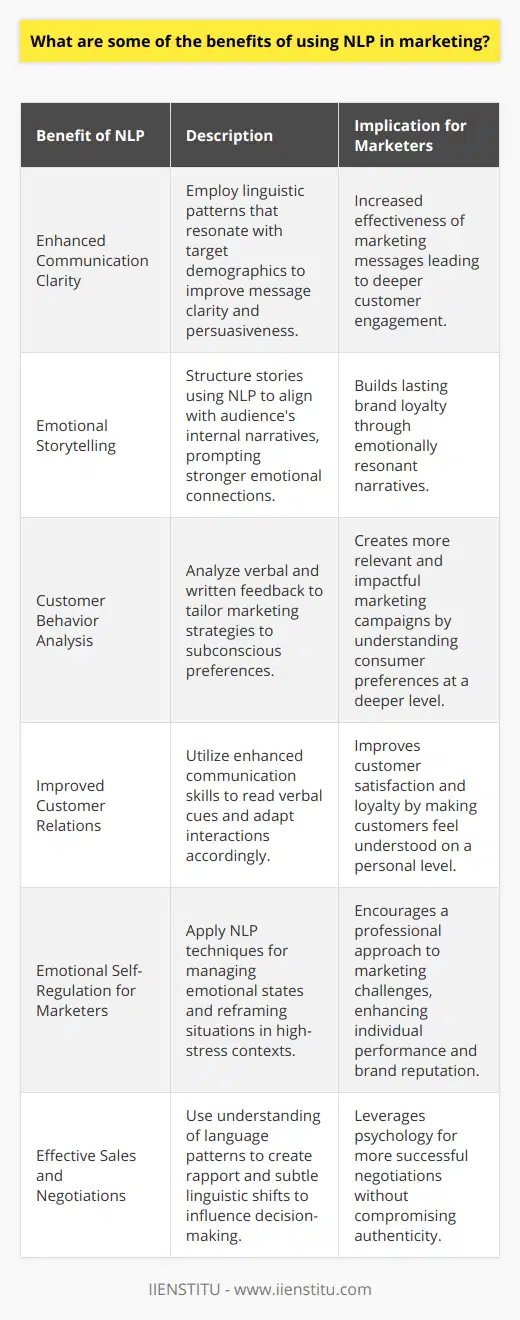
How does NLP differ from traditional marketing methods?
There are a few key ways in which NLP (natural language processing) differs from traditional marketing methods. Firstly, NLP is able to automatically process and extract information from large amounts of unstructured text data. This is in contrast to traditional marketing methods which often rely on manually processing data, or analyzing small samples of data. Secondly, NLP can be used to generate comprehensive reports and insights about customer trends and preferences. This is again in contrast to traditional marketing methods where obtaining such insights may be more difficult and time-consuming. Finally, NLP can be used to develop highly personalized recommendations and content for individual customers. This is something that is not really possible with traditional marketing methods. In summary, NLP provides a more.
How is the application of neuro-linguistic programming impacting sales outcomes?
Effectiveness of Neuro-Linguistic Programming in Sales
Enhanced Communication Skills
The application of neuro-linguistic programming (NLP) has significantly impacted sales outcomes by improving the communication skills of sales professionals. NLP helps them understand and respond to the needs and desires of their customers more effectively. By mastering the subtle aspects of language, rapport building, and persuasion, they are able to create more compelling sales pitches and close deals more efficiently.
Increased Emotional Intelligence
Additionally, NLP techniques increase a salesperson's emotional intelligence, which is vital for success in sales. Emotional intelligence is the ability to recognize, understand, and manage one's emotions and the emotions of others. This ability helps sales professionals better empathize with customers, identify potential objections, and address them proactively, hence leading to better sales outcomes.
Adaptability to Different Personality Types
One of the critical aspects of NLP is its emphasis on understanding distinct personality types and adapting communication styles accordingly. This adaptability allows salespeople to tailor their approach to individual customers, making their pitches more relatable and persuasive. As a result, the application of NLP in sales enables professionals to cultivate fruitful relationships with diverse clientele, consequently generating higher revenue.
Application in Training and Development
Another way NLP impacts sales outcomes is through its integration into sales training and development programs. Techniques derived from NLP enable trainers to create more engaging and effective learning experiences for sales professionals. By applying NLP methodologies to training, organizations can equip their sales teams with essential skills and the confidence to excel in their roles.
Overcoming Limiting Beliefs
Finally, NLP techniques play a crucial role in helping sales professionals overcome limiting beliefs and self-imposed barriers. These beliefs hinder their ability to reach their full potential in a sales setting. Through NLP, they can reframe their mindset, replace negative thought patterns with positive ones, and achieve a more optimistic outlook. As a result, they gain increased self-confidence and heightened motivation to excel in their sales performance.
In conclusion, the application of neuro-linguistic programming contributes to better sales outcomes by enhancing the abilities of sales professionals in terms of communication, emotional intelligence, adaptability, training, and overcoming limiting beliefs. By adopting NLP techniques, both sales professionals and organizations can achieve significant improvements in their sales performance and overall revenue generation.
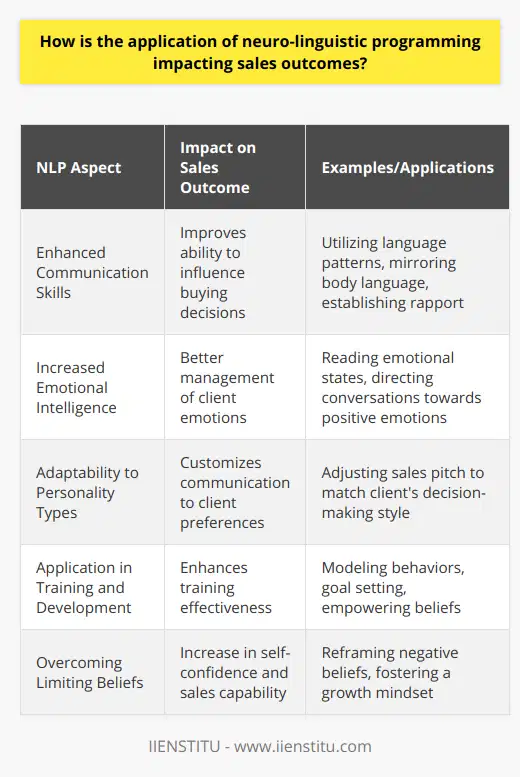
In what ways does NLP contribute to the evolution of marketing techniques and strategies?
**NLP and Marketing Evolution**
Natural Language Processing (NLP) significantly contributes to the evolution of marketing techniques and strategies in various ways, primarily by enhancing audience engagement, supporting data-driven decision-making, and enabling personalized marketing.
**Enhancing Audience Engagement**
NLP enables marketers to understand and replicate the language, sentiment, and tone used by their target audience, making the content and messages more relatable and engaging. By analyzing large volumes of text data from social media platforms, websites, reviews, and customer inquiries, NLP algorithms help identify crucial linguistic patterns and trends that can be employed in marketing campaigns, leading to better engagement with potential customers and improved retention.
**Supporting Data-Driven Decision Making**
The use of NLP in marketing also empowers data-driven decision-making, allowing businesses to make strategic decisions based on insights derived from data analysis. Unstructured text data, such as comments, feedback, and online reviews, are analyzed by NLP algorithms to determine customer preferences, concerns, and product performance. These insights help marketers adjust their strategies, formulate targeted messaging, and optimize their offerings to meet the customers' needs better.
**Enabling Personalized Marketing**
NLP enhances personalized marketing efforts by providing a comprehensive understanding of the individual preferences of customers. It enables marketers to tailor promotional messages, offer relevant product recommendations, and create content that appeals directly to specific customer segments. By using NLP to analyze individual customer behavior and preferences, businesses can develop targeted, relevant, and timely marketing campaigns, significantly increasing conversion rates and customer loyalty.
In conclusion, Natural Language Processing is a vital tool in the evolution of modern marketing techniques and strategies. Its ability to enhance audience engagement, support data-driven decision-making, and enable personalized marketing allows businesses to create more effective and targeted marketing campaigns. As advancements in NLP continue to develop, its potential applications and benefits for marketing will undoubtedly expand, presenting new opportunities for businesses to connect with their audience and optimize their marketing efforts for maximum impact.
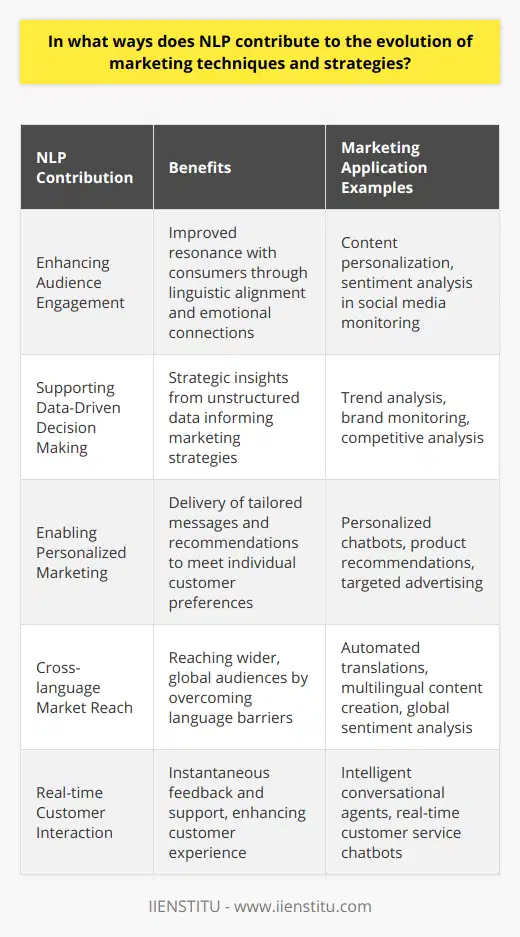
Considering rapid technological advancements, to what extent does NLP maintain its relevance in the marketing and sales industries?
NLP Relevance in the Context of Technological Advancements
The rapid technological advancements witnessed in recent times have had a significant impact on various industries, including marketing and sales. One of the critical technologies that have emerged and evolved in recent years is Natural Language Processing (NLP). NLP refers to a subset of artificial intelligence (AI) that enables computers to understand, interpret, and respond to human language. By assessing the extent to which NLP maintains its relevance in the marketing and sales industries, it is essential to examine the specific applications of this technology and how it continues to revolutionize marketing and sales operations in the context of technological advancements.
Personalized Marketing with NLP
NLP has profoundly impacted the marketing industry by enabling personalized marketing efforts. By analyzing consumers' language use, NLP allows marketers to better understand their target audience's preferences, needs, and buying behaviors. This understanding, in turn, facilitates the delivery of tailor-made marketing messages, improving campaign effectiveness and ROI. Furthermore, NLP-powered tools can generate relevant and engaging content for consumers, ensuring that marketing efforts resonate with the target audience on a deeper level.
Enhancing Customer Service
Customer service has become a crucial differentiator in the marketing and sales industries. NLP streamlines the customer service process by automating various aspects of communication. For example, NLP-powered chatbots can handle customer inquiries more effectively and efficiently, translating to increased customer satisfaction and higher sales conversions. Additionally, NLP can extract insights from customer feedback to identify areas of improvement, enabling businesses to optimize their offerings and provide exceptional customer experiences.
Optimizing Sales Strategies
In the sales industry, NLP has become an indispensable tool for optimizing sales strategies. Through sentiment analysis, NLP can examine customers' emotions and opinions, enabling sales teams to identify patterns and trends that can inform their approach. Furthermore, NLP can be integrated with CRM systems to enhance lead scoring, allowing businesses to prioritize high-quality leads and allocate resources more effectively. This capability not only improves sales performance but also ensures that businesses can maintain their competitiveness in an ever-evolving technological landscape.
In conclusion, natural language processing continues to maintain its relevance in the marketing and sales industries due to its invaluable applications in personalized marketing, customer service, and sales strategy optimization. As technological advancements persist, NLP will likely play an increasingly critical role in shaping business success, making it an essential technology for marketing and sales professionals to adopt and utilize.
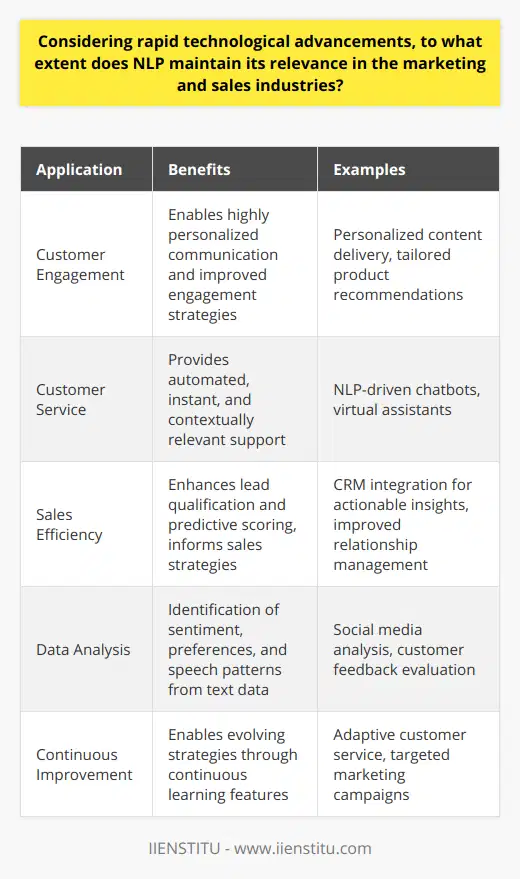
How is NLP successful in selling?
NLP in Sales Techniques
Neuro-linguistic programming (NLP) can be extremely successful in selling due to its strategic communication techniques. By leveraging NLP, sales professionals can establish rapport and trust with clients, persuasively present their offerings, and effectively address objections.
Establishing Rapport and Trust
Firstly, NLP helps salespeople create rapport with their target audience, a crucial element in sales communication. Essential tools such as mirroring body language, matching speech patterns, and active listening allow sales professionals to better understand their clients' needs and preferences. This understanding facilitates the formation of strong connections and fosters trust between the clients and the sales representative.
Persuasive Presentation of Offerings
Secondly, NLP emphasizes the importance of framing sales pitches persuasively. According to NLP principles, crafting messages that elicit positive emotions in clients can significantly improve the response rates to sales offerings. By understanding clients' unique modes of processing information, sales professionals can also customize their pitch to the clients' preferred linguistic style, making it more accessible and engaging.
Overcoming Objections Effectively
Lastly, NLP equips sales representatives with the necessary skills to effectively address clients' objections. The reframing technique, for instance, can be employed to showcase the benefits of a product or service from an opposing perspective, potentially dispelling initial concerns. Additionally, NLP helps sales professionals to identify underlying motivations behind clients' objections and respond accordingly, ensuring optimal sales outcomes.
In conclusion, the success of NLP in selling can be attributed to its focus on rapport building, persuasive communication, and effective objection handling. By incorporating NLP techniques, sales professionals can create trust with clients, improve the impact of their sales pitches, and address objections promptly, thereby improving overall sales results.
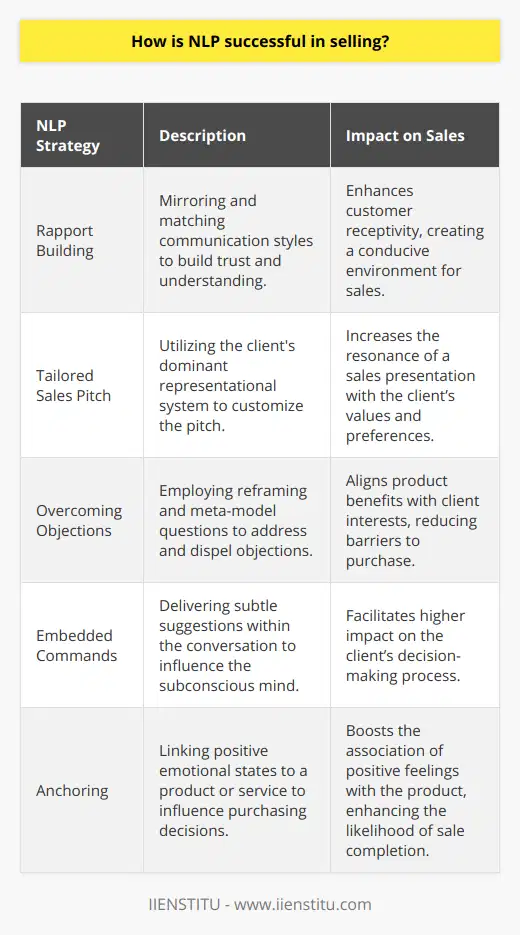
What does NLP stand for in marketing?
Definition of NLP in Marketing
In the field of marketing, NLP stands for Natural Language Processing. It refers to the interaction between humans and computers through the use of natural language. This technology enables computer systems to understand, interpret, and generate responses to human-like textual data, enhancing the efficiency of communication in the digital age.
Implementation of NLP in Marketing Strategies
NLP can be employed in various marketing strategies to improve customer experience and personalize marketing campaigns. For instance, it can be used to analyze customer reviews, social media posts, and other textual data, generating valuable insights for businesses. This information allows marketers to tailor their marketing efforts based on consumers' preferences and sentiments, ultimately increasing brand loyalty and driving sales.
Role of NLP in Chatbots
A prominent application of NLP in marketing is the development of chatbots. These are automated systems that communicate with customers through text or voice, simulating human conversations. By leveraging NLP capabilities, chatbots can understand complex queries, respond with relevant information, and provide personalized recommendations, hence enhancing customer engagement and satisfaction.
NLP in Sentiment Analysis
Sentiment analysis is another critical area where NLP is applied in marketing. This involves processing large amounts of unstructured data, such as online reviews and social media comments, to determine the users' overall sentiment towards a brand, product, or service. This valuable feedback helps companies gain a better understanding of customer perceptions and preferences, which are crucial in formulating more targeted and effective marketing strategies.
NLP in SEO and Content Marketing
NLP also plays a significant role in Search Engine Optimization (SEO) and content marketing. With NLP algorithms, search engines can better understand the context, intent, and relevance of web content, resulting in more accurate search results. Consequently, marketers can utilize NLP techniques to optimize their content, ensuring that it aligns with both user intent and search engine guidelines, ultimately leading to improved search rankings.
Conclusion
In sum, Natural Language Processing (NLP) has become an indispensable tool in marketing, as it enables businesses to interact with their customers using human-like language. The numerous applications of NLP in marketing, such as chatbot development, sentiment analysis, and SEO, have significantly improved customer experiences and facilitated the creation of more effective, personalized marketing campaigns. As technology continues to develop, NLP will undoubtedly play an increasingly vital role in the marketing landscape.
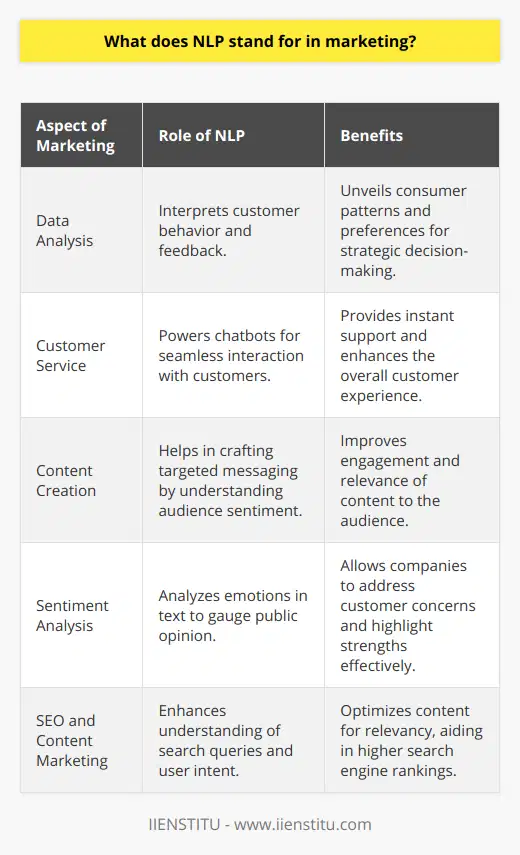
Why is NLP useful in e-marketing?
Significance of NLP in E-marketing
Enhancing Customer Experience
Natural Language Processing (NLP) is essential in e-marketing because it improves customer experience, helping businesses understand and connect with their audience on a deeper level. By analyzing user-generated content, such as social media posts or customer reviews, NLP tools can detect consumer sentiment and preferences towards specific products or services. This analysis enables businesses to adjust their marketing strategies, resulting in better-targeted, more effective campaigns that cater to customer needs.
Streamlining Communication
NLP is also useful for streamlining communication between businesses and consumers. Chatbots, for instance, leverage NLP technologies to understand user inquiries and provide relevant information. Consequently, they offer real-time, personalized engagement, reducing response times, and optimizing the conversion process. This high level of customer service can lead to increased trust, loyalty, and repeat purchases from customers.
Increasing Productivity
The implementation of NLP in e-marketing also helps companies increase productivity. With the ability to process large volumes of data from various sources, NLP tools can automatically categorize, summarize, and analyze information, saving time and minimizing manual effort. This enables marketing professionals to focus on more critical tasks, such as developing targeted strategies and fostering meaningful relationships with customers, ultimately improving overall performance.
Gaining Competitive Advantage
Businesses that leverage NLP technology are better positioned to gain a competitive edge, thanks to the innovative insights derived from its analytical capabilities. By extracting valuable information from unstructured data, NLP allows e-marketers to design personalized experiences and campaigns that cater to specific audience segments. This targeted approach can ultimately lead to a more efficient use of marketing resources, increased conversions, and improved return on investment.
In conclusion, Natural Language Processing offers numerous benefits in e-marketing, ranging from enhanced customer experience to increased productivity and a competitive advantage. Harnessing the potential of NLP can enable businesses to engage more effectively and innovatively with their customers, driving the success of their marketing efforts in today's rapidly evolving digital landscape.
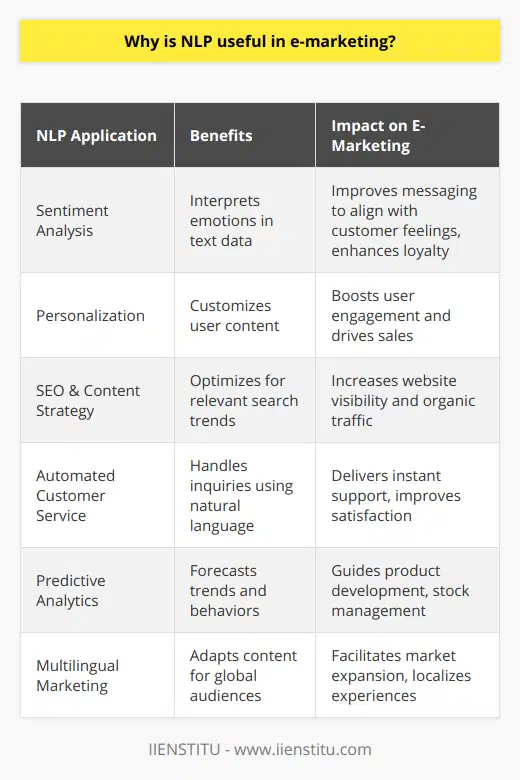
How does the integration of NLP techniques enhance the overall effectiveness of marketing campaigns?
NLP Application in Marketing
The integration of natural language processing (NLP) techniques greatly enhances the overall effectiveness of marketing campaigns by offering a deeper understanding of consumer behavior and preferences. When marketers employ NLP technologies, they benefit from improved content creation and promotion strategies, leading to better results and higher return on investment (ROI).
Consumer Insights
NLP techniques allow marketers to collect and analyze vast amounts of unstructured data, such as social media posts, online reviews, and customer feedback. This data analysis leads to valuable consumer insights which enable marketers to tailor their content and messaging to better resonate with their target audience. By utilizing NLP techniques, marketers can also identify current market trends and effectively predict future consumer demands.
Sentiment Analysis
One of the most powerful NLP-driven marketing techniques is sentiment analysis. Through this method, marketers can gauge public opinion about their products, services, or brand in general. Sentiment analysis helps marketers uncover positive or negative patterns in customer opinions, which allows them to address concerns, celebrate successes, and make data-driven decisions on future marketing initiatives.
Improved Targeting
NLP techniques help improve the precision of targeting in marketing campaigns by analyzing the language used by consumers in various online forums. This data enables marketers to create more engaging content and personalized messages tailored to particular audience segments. Consequently, this increases the likelihood of capturing potential customers' attention, which leads to higher conversion rates.
Automated Content Generation
NLP-driven algorithms can support the generation of automated content, including customized email campaigns, social media updates, and blog articles. These algorithms can help marketers save time and resources by streamlining the content creation process. With the ability to automatically produce relevant and engaging content, marketers can focus on refining their overall marketing strategy.
Enhanced Social Media Monitoring
Employing NLP techniques enables marketers to effectively monitor social media conversations and engage with their online audience. By understanding the real-time sentiment and opinions of their target audience, marketers can establish a more genuine connection with potential customers, respond to critical feedback, and create a better overall brand experience.
In conclusion, the integration of NLP techniques significantly enhances the overall effectiveness of marketing campaigns by providing valuable consumer insights, improving targeting, and streamlining content generation. By utilizing these advanced technologies, marketers gain a competitive edge in the rapidly changing digital landscape.

In what ways can NLP be utilized to better understand consumer behavior and decision-making processes?
Examining Customer Preferences through NLP
Natural Language Processing (NLP) can be applied to better understand consumer behavior and decision-making processes through several methods. By analyzing text data sources, such as product reviews, social media comments, and customer inquiries, companies can gain insights into customer preferences, interests, and habits. This facilitates the creation of tailored marketing campaigns and personalized product recommendations, positively impacting sales and customer satisfaction.
Sentiment Analysis for Marketing Insights
One application of NLP particularly useful in analyzing consumer behavior is sentiment analysis. This technique involves mining textual data to determine the emotions behind the opinions expressed by consumers. By identifying positive, negative, or neutral sentiment, companies can gauge customer satisfaction and tailor marketing strategies accordingly. The collected data may also be used to predict future trends and sentiments towards specific products or services, enabling more effective decision-making.
Discovering Latent Consumer Needs
Another way NLP can be used to uncover consumer behavior is through topic modeling. This method groups together similar words and phrases from customer-generated content to discover underlying themes and patterns. By extracting these topics, companies can identify unmet needs or uncover pain points experienced by their customers. Addressing these issues will not only improve customer satisfaction but also drive innovation and enhance product development.
Analyzing Personal Communication Styles
NLP can also shed light on consumer behavior by examining the language customers use when communicating with companies. Analyzing communication styles and preferences can provide valuable insights into how well a company's messaging resonates with their target audience. This understanding can inform marketers and sales teams on how to communicate more effectively and persuasively with customers, ultimately improving conversion rates and brand loyalty.
In conclusion, Natural Language Processing enables a deeper understanding of consumer behavior and decision-making processes through various techniques. By leveraging NLP's text analysis capabilities, companies can identify customer sentiment, discover latent needs, and analyze communication styles. These insights can inform more effective marketing strategies, efficient product development, and enhanced customer engagement.
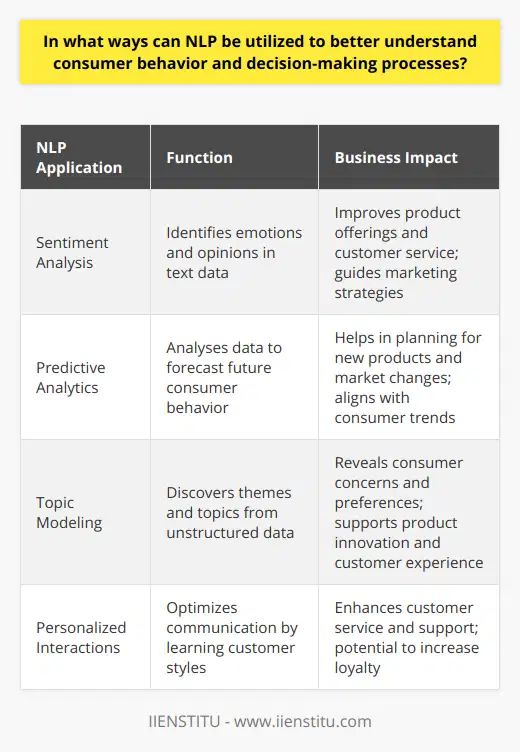
What role does NLP play in facilitating more personalized and targeted marketing approaches?
Role of NLP in Personalized Marketing
Understanding Consumer Needs
Natural Language Processing (NLP) plays a crucial role in analyzing vast amounts of unstructured data, such as customer reviews and social media comments, to understand consumer needs better. By identifying specific keywords, phrases, and sentiments, NLP allows marketers to develop well-informed, targeted marketing strategies that cater to consumers' preferences.
Creating Tailored Content
NLP-based systems, such as content generation tools and chatbots, contribute to creating tailored content for individual consumers. These tools utilize NLP algorithms to craft personalized messages, product descriptions, and advertising content that resonates with customers, resulting in higher engagement levels and customer satisfaction.
Improving Customer Segmentation
Customer segmentation is vital for delivering targeted marketing campaigns, and NLP facilitates this by categorizing customers based on their online behavior, language, preferences, and opinions. This segmentation allows marketing professionals to design customized promotional materials and strategies for various customer groups, enhancing overall marketing effectiveness and return on investment.
Enhancing Customer Support
NLP-enhanced marketing automation platforms enable businesses to provide proactive and personalized customer support, improving the user experience. By analyzing customers' language, tone, and context in their communication, support teams can better understand specific issues and cater to them accordingly, creating an empathetic and customized service.
Real-time Marketing Decision Making
NLP technologies allow for real-time analysis of consumer-generated data, resulting in valuable insights for marketers. This enables businesses to identify emerging trends, customer preferences, and potential issues rapidly, allowing them to adapt their marketing strategies accordingly and maintain a competitive edge in the market.
In conclusion, NLP plays a pivotal role in facilitating more personalized and targeted marketing approaches by providing insights into customer needs, enabling the creation of tailored content, improving customer segmentation, enhancing customer support, and supporting real-time marketing decision-making. These advantages contribute to a more effective and efficient marketing strategy that aligns with consumers' preferences, ultimately positively influencing brand reputation and boosting business performance.
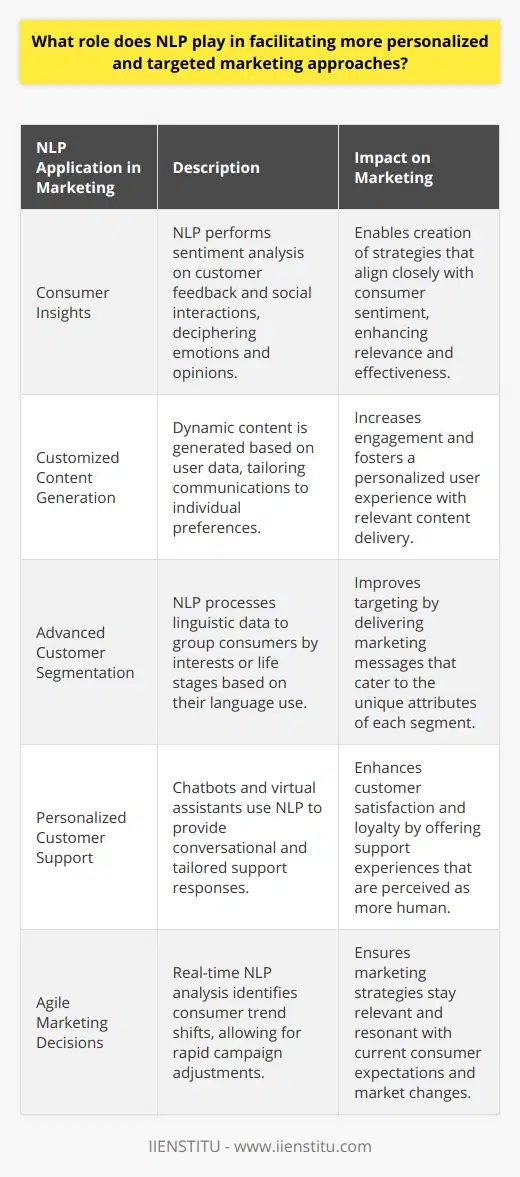
What factors contribute to the efficacy of NLP in improving marketing communication and messaging?
Effective Keyword Use
The efficacy of Natural Language Processing (NLP) in enhancing marketing communication and messaging stems from several factors. A prime factor is the effective use of keywords. NLP can analyze customers' language to determine the most used and impactful keywords. By incorporating these keywords into marketing strategies, businesses can improve communication and message efficacy.
Improved Targeting
Another influencing factor is improved targeting. Through NLP, we can identify specific customer segments based on language patterns and preferences. This supports the creation of personalized and targeted marketing strategies, thus increasing effectiveness.
Sophisticated Sentiment Analysis
Sentiment analysis facilitated by NLP is another critical factor. It empowers businesses to understand customers' emotions towards their products or brand. By leveraging this information, businesses can address any issues and enhance positive sentiments, thus promoting effective communication.
Astute Customer Segmentation
Lastly, NLP helps improve customer segmentation based on their language styles and preferences. This results in more relevant and engaging communication, leading to better marketing results.
In conclusion, NLP enhances marketing communication and messaging by effectively utilizing keywords, improving targeting and segmentation, and enabling sophisticated sentiment analysis. However, its successful implementation requires a thorough understanding of these factors and a strategic application for optimum results.

How does the incorporation of NLP principles in digital marketing enhance customer engagement and brand loyalty?
Understanding Customer Needs through NLP
Natural Language Processing (NLP) in digital marketing can significantly enhance customer engagement. By processing and analyzing customer language, marketers can understand their needs, preferences and sentiments. This deep understanding can result in highly personalized experiences for the customer.
Personalization and Customer Engagement
Personalization fosters an emotional connection between the user and the brand, enhancing customer engagement. This connection can often happen when customers see messages tailored precisely to their interests. With NLP, marketers can decipher word choices, sentiments, and tone, allowing them to customize their messaging effectively.
Predictive Customer Analysis
NLP also allows for predictive customer analysis. Predictive analysis can help anticipate customer behavior and preferences, allowing the brand to offer more targeted and appealing content. Furthermore, satisfied customers are more likely to engage with the brand, enhancing loyalty.
Brand Loyalty
Finally, brand loyalty can see a considerable boost from the incorporation of NLP in digital marketing. By ensuring customer messages are fully understood and by communicating in a manner that resonates with them, brands can cultivate a sense of trust. Trust fuels loyalty, leading to repeat purchases and long-term customer relationships.
In conclusion, the incorporation of NLP principles in digital marketing can improve customer interaction, satisfaction, and loyalty. By understanding and predicting customer needs, implementing personalization, and cultivating trust, brands can leverage NLP to enhance their customer relationship management strategy.

In what ways can NLP techniques lead to more effective cross-channel marketing efforts?
Enhancing Targeted Messaging
Natural Language Processing (NLP) techniques can massively boost the effectiveness of cross-channel marketing. A key way is through enhancing targeted messaging. NLP enables marketers to understand customers on a deeper level, dissecting their reviews, comments, and general online behavior.
Understanding Customer Sentiments
The analysis of customer sentiments makes it easier to tailor personalized marketing strategies. NLP algorithms can evaluate customer sentiments from various data sources. This gives marketers valuable insights for crafting persuasive and relatable marketing messages.
Semantic Analysis For Greater Personalization
Further, NLP allows semantic analysis, studying the meanings behind the words customers use. This aids marketers in curating messages that resonate with customers' needs, preferences and emotions. With such precise personalization, marketing campaigns can hit the bull’s eye more often.
Streamlining Automated Responses
NLP also streamlines automated responses in cross-channel marketing. Quick, effective responses to customer queries enhance the customer experience. NLP-driven response systems interpret and respond to customer queries in real-time, leading to increased customer engagement and satisfaction.
Improving SEO Strategies
Finally, NLP improves Search Engine Optimization (SEO) strategies. It aids in understanding how potential customers use language when searching online. This knowledge informs the creation of more effective content and keyword strategies. Thus, employing NLP can help marketers reach customers efficiently, boosting visibility and consequently improving return on investment (ROI).
In conclusion, NLP empowers marketers to understand and connect with their customers on a deeper level. This leads to a more organized approach, personalized marketing efforts, and effective communication – all vital for successful cross-channel marketing.
